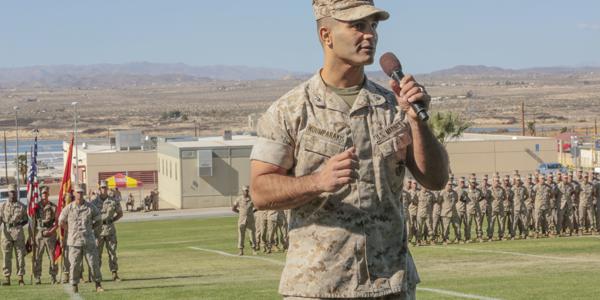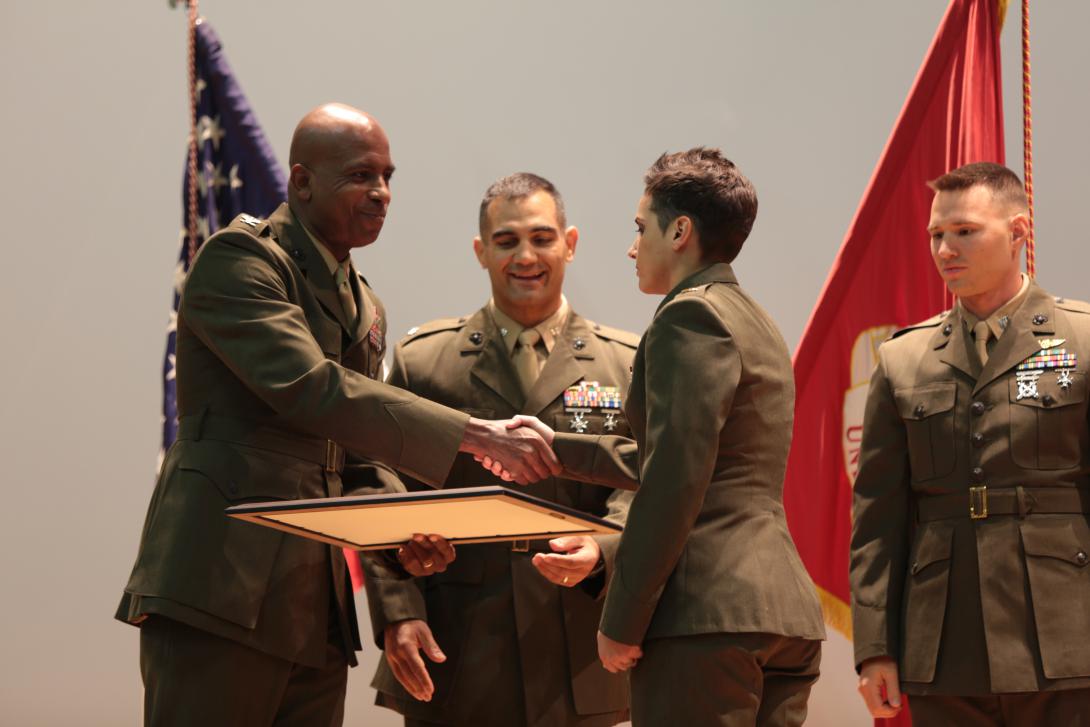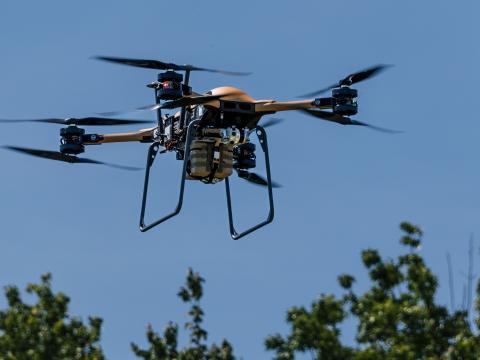Marine Corps Communicators Consolidate Training
The U.S. Marine Corps has consolidated its communications and command and control training under a single organization at its major base in Twentynine Palms, California. This move, which included transferring some training and associated equipment from Quantico, Virginia, enables related elements to work more interoperably as well as in a broad-spectrum Marine Corps operational environment. Officers, noncommissioned officers and entry-level personnel all train together at the new facility.
The Marine Corps Communication-Electronics School (MCCES) has completed a reorganization that consolidated three previously disparate and dispersed elements. Originally, MCCES was a battalion-type headquarters with directly subordinate companies. Now, it is a regimental-style headquarters that includes the newly established air control training squadron (ACTS) and the communication training battalion (CTB), both headed by lieutenant colonels and all located at Twentynine Palms. It also has taken on new responsibilities for some schools and training sections. This restructuring formally was approved late last year.
Col. Andrew J. Murray, USMC, the commanding officer of MCCES, emphasizes the traditional view of the MCCES might be that of a communications school. But now it is much broader and more significant than that blanket identification.
“MCCES trains Marines to enable MAGTF [Marine Air-Ground Task Force] command and control,” Col. Murray declares.
The driving force for this consolidation was to improve training in communication and command and control, Col. Murray offers. A study initiated several years ago by a prior commanding officer examined the benefits of reorganizing MCCES and relocating its elements at Twentynine Palms. Col. Murray notes that one earlier option had considered relocating the Quantico communication school to the U.S. Army’s Signal Center at Fort Gordon, Georgia. However, that option failed the test of feasibility, and the subsequent commander examined the Twentynine Palms option. Over the intervening years, various other consolidations occurred at Twentynine Palms.
Lt. Col. Douglas Hardy, USMC, ACTS commanding officer, offers that the consolidation largely is about academics. Traditionally, an infantry battalion would be learning how to attack a hill and secure an objective, but at MCCES, the consolidation has improved academics for its trainees. The school has been able to upgrade the education of all the organizations that have moved to Twentynine Palms. The consolidation also allows easier upgrades and ensures that improvements in one area are available to all where applicable.
Col. Hardy notes the previous MCCES construct severely limited the abilities of its commander, who was responsible for 3,000 people with no subordinate commanders at the lieutenant colonel level. All authorities had to be done by this single colonel, who might be called on to sign up to 600 promotion warrants each month. This administrative work sapped valuable time that otherwise might be spent on more important tasks, such as reaching out to vital Marine and joint communities, he says.
The reorganization has enabled the presence of the two lieutenant colonels to free the commanding colonel to reach out to a higher level. The change has been significant, Col. Hardy says, describing it as beneficial for the entire MCCES.
Lt. Col. Speros C. Koumparakis, USMC, commanding officer of the CTB, relates that he originally took command of the officers’ communication school in Quantico in June 2014—effectively inheriting the move. MCCES already was in the process of reorganizing, so the Quantico facility graduated its final classes last summer. Concurrently, the CTB moved much of its equipment to MCCES at Twentynine Palms and reduced its staff by more than 25 percent. A company formerly under MCCES was moved into the CTB and restructured. Another formerly located in Quantico moved to California.
One company that used to be in charge of enlisted training now focuses on entry-level training—advanced training for entry-level Marines after completion of boot camp and combat training that transitions them into skilled communicators supporting ground forces. This expertise encompasses radio and transmission, telephone switching and cyber network operations, Col. Koumparakis says.
The other company originally was the officer training company at Quantico. It has been shaped into a staff noncommissioned officer (NCO) and officer training unit with skills progression encompassing the same skills as the other company, but for higher-ranking Marines. It includes a systems chief course starting at the staff sergeant level, a communications chief course for gunnery sergeants and master sergeants, and an information assurance technician course for cyber network defenders. This training also has an officers’ side: basic communication officers, such as lieutenants; advanced communication officers, such as captains and majors transiting from tactical to operational communication; and warrant officer courses, which begin this month.
Other units under the CTB include communication training centers at Camp Lejeune, North Carolina, Camp Pendleton, California, and Okinawa, Japan. These provide enhancement training for skills progression, Col. Koumparakis notes.
The CTB graduated its first class of 77 lieutenants in April. Col. Koumparakis relates that more than half of these lieutenants told him they had met a staff NCO in the school that they would be working with in the fleet in the coming month. “We now have an opportunity to create a shared bond that never has been in the communications community—where a lieutenant understands what their enlisted Marines go through for their training to become communicators,” the colonel declares.
Col. Hardy allows that he also has seen changes in the communications officers who attend the school as they interact with their enlisted Marines in the program. “It really gives them a breadth of experience, and they start to build these relationships with people they might not have come in contact with until they actually hit the operational forces,” he reports. “It’s a little bit of a confidence builder as you hit the ground running.”
The Twentynine Palms location offers its own advantages to Marine Corps training, Col. Koumparakis points out. “Every Marine ground communicator trains in the exact same place at school that he or she will train in with their units one or two years down the road,” he explains. In effect, the desert environment at Twentynine Palms serves as a surrogate for a deployment.
“It’s almost like cheating for the test,” he says. “We give the ground communicators the keys to the castle, so they should support their commanders even better.”
All three Marine officers emphasize that training at Twentynine Palms leaves their students more connected to the Corps as a whole. The broad facilities at Twentynine Palms provide a form of total immersion to the MCCES trainees during their time there. Col. Koumparakis states that MCCES has great relationships with all the Marine organizations at Twentynine Palms, and the other organizations help supplement any needs lacking in MCCES by providing their own support.
“The bottom line is, we are providing the operating forces with better trained Marines—both officer and enlisted—in aviation command and control, in communications and in all of the other MOSs [military occupational specialties] that we teach here at the schoolhouse,” Col. Murray declares.
Col. Hardy describes ACTS as split down the middle between operators and maintainers. One company is responsible for ground radio maintenance. It includes entry-level students, operational force students and warrant officers. The other company trains command and control officers for air control. ACTS includes radar maintainers, low-altitude air defense gunners and the advanced explosive ordnance disposal training center, Col. Hardy adds.
He continues that much of ACTS’ work is tied to the CTB in many ways through communications. Having the two organizations under the same umbrella and in the same location is “a great way to do business,” he emphasizes.
The Marine Corps aviation command and control community has a new system of record—the Common Aviation Command and Control System, or CAC2S. It comprises radios, networks and virtual servers, and until now it has been largely a closed project, Col. Hardy says. Now, cyber operators undergoing training in the CTB can be brought over to the ACTS arena to increase their familiarity with it—and improve its security prospects among its users.
The consolidation also enables the Marines to train on the latest communications technology. Col. Koumparakis relates the Corps is receiving a new telephone switch with a new call manager system, and the school is able to incorporate that new gear in its training only nine months after its Marine Corps-wide acquisition was approved.
Col. Murray notes MCCES is preparing to teach a very small aperture terminal (VSAT) communications equipment entry-level course at its extension facility in Fort Gordon. This has not been taught previously at the Fort Gordon facility, he notes.
The overall move went fairly well, the officers note. Some problems did emerge, especially in terms of the condition of the equipment that had to be moved from Quantico. Maintaining that gear did slow the process a bit, but it did not impede the MCCES, Col. Koumparakis allows. The only delay came in the start of one officers’ course, which was pushed back two and a half months. By fall 2015, the school should be completely caught up with any backlog, he added.
Col. Murray admits the school has suffered from ongoing budget constraints—the “zero-growth opportunity,” as he describes it, while establishing the two additional headquarters within MCCES. The benefits outweigh the challenges, he emphasizes, “but it would be nice in some key areas to have a few more billets filled.”
Col. Hardy concedes that this no-growth doctrine still allows them to do their job, but he hopes eventually to obtain key billets that will strengthen academics and increase the efficiency of the school. He is leaving ACTS, and Col. Murray is stepping down as MCCES commander in July, so new commanders will inherit the new school and its plans for improvement. This future may include further consolidation of training for communication and command and control at MCCES.
Col. Murray adds that technology advances may be major drivers in additional changes at MCCES in the coming years. Also, the Marine Corps—as are the other services—still is determining everyone’s role in cyber. He expects significant change across the MCCES in the coming years as the Corps makes that determination both in terms of use and operation.
“We have a tactical advantage [in training for cyber],” Col. Murray declares. “Our Marines plan, develop, build, install, operate and maintain communications networks. We actually build the environment we operate in, so who better to defend that network than the person who builds it? As we move along, we can leverage and be dominant of the domain that we build.”





Comments